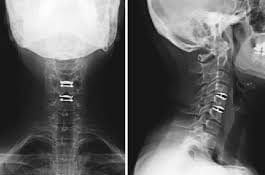What is cervical disc replacement surgery?
Cervical disc replacement surgery or cervical disc arthroplasty is a surgical procedure in which a damaged cervical intervertebral disc is replaced by a mechanical artificial disc, usually made from titanium combined with other materials.

Although the artificial disc may lack some of the absorptive qualities of the biological disc, it does allow for the natural motion that occurs at the spinal segment between two vertebrae. Examples include Mobi-C (shown), Prestige LP and Prodisc-C.
Why is cervical disc replacement surgery performed?
Cervical disc replacement surgery may be performed to remove a damaged intervertebral disc that has herniated and compresses the nerve roots that travel to the upper extremities. In other cases, a cervical artificial disc can be used to replace a degenerative cervical disc that causes debilitating neck pain and often results in stenosis or narrowing of the bony canal through which the nerve roots exit the spinal cord. The pinching of the nerve roots may result in numbness, tingling and/or weakness involving one or more upper extremity.

What is the alternative to cervical disc replacement surgery?
A damaged cervical intervertebral disc may also be removed and replaced by a bone plug or allograft for purposes of fusing two cervical vertebrae together. Cervical fusion is the classic way to deal with many cervical pathologies. Cervical disc arthroplasty was designed in an effort to maintain the natural motion between 2 cervical vertebrae. It is believed that the maintenance of natural motion may prevent adjacent segment disease that may eventually occur following cervical fusion. The decision regarding when to use an artificial cervical disc remains controversial.
Conserving motion within the vertebral segment may help prevent adjacent level disease, especially when the adjacent level is unhealthy. However, the preservation of motion may also allow for continued degenerative changes or eventual hardware failure within the treated segment.
What are the potential complications of cervical disc replacement surgery?
Artificial cervical disc spine surgery is performed to treat a spinal condition and preserve the natural mobility of the spinal segment. However, sometimes maintaining the spinal motion in a degenerative segment allows for continued spinal segment degeneration. It is often the motion that creates the degenerative changes over time and results in conditions such as degenerative disc disease, facet arthropathy and spinal stenosis. Other patients simply do not tolerate the foreign body (i.e., artificial cervical disc) within the intervertebral disc space which can create a focus of chronic irritation and inflammation. Some patients experience persistent pain, numbness, tingling and weakness after cervical disc arthroplasty surgery. Other patients complain of new symptoms not experienced previously such as jaw and facial pain, cervical headache and activity-related neck and upper extremity pain.
What are the treatment options for failed cervical disc replacement surgery?
When cervical disc replacement surgery fails, the treatment options include anterior revision (i.e. removal of artificial disc followed by decompression and fusion) versus posterior fusion. Many surgeons prefer to address the problem by fusing the spinal segment using the posterior approach. However, this approach does not remove the artificial disc and may not address residual or recurrent stenosis that results in compression of the spinal cord or nerve roots. Using the anterior approach, an incision is made through the prior incision, the artificial disc is removed, the disc space is cleaned out and the neural elements are decompressed. A bone plug is then placed and the 2 vertebral bodies are allowed to fuse together, thereby removing all motion and preventing further degenerative changes involving the damaged spinal segment.
Why did my surgeon not offer me revision surgery for failed cervical disc replacement surgery?
Revision artificial cervical disc surgery using the anterior approach through the prior incision is a technically challenging endeavor. Many spine surgeons lack the experience and comfort level necessary to surgically correct this condition using an anterior approach. At Princeton Neurological Surgery, Dr. John Lipani has extensive experience correcting failed artificial cervical disc surgery using the anterior approach. His patients are often relieved to finally realize a solution to their failed cervical disc arthroplasty surgery.
Schedule a consultation
Schedule a consultation with Dr. Lipani to learn more about cervical disc replacement surgery revision and what surgical options are available for you. Call us at (609) 890-3400. We are conveniently located in Mercer, Somerset, Morris, Union and Bergen Counties.


